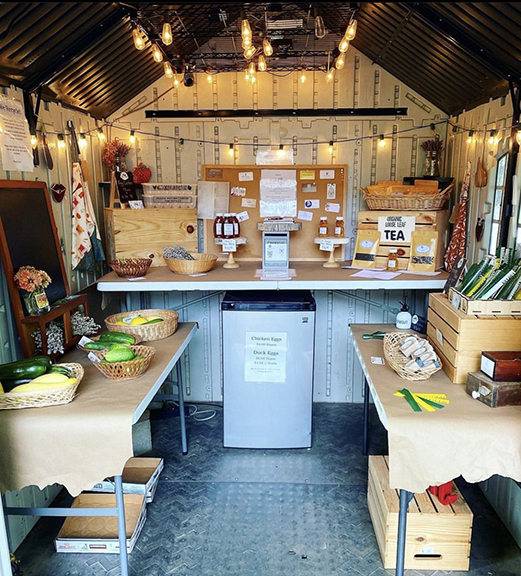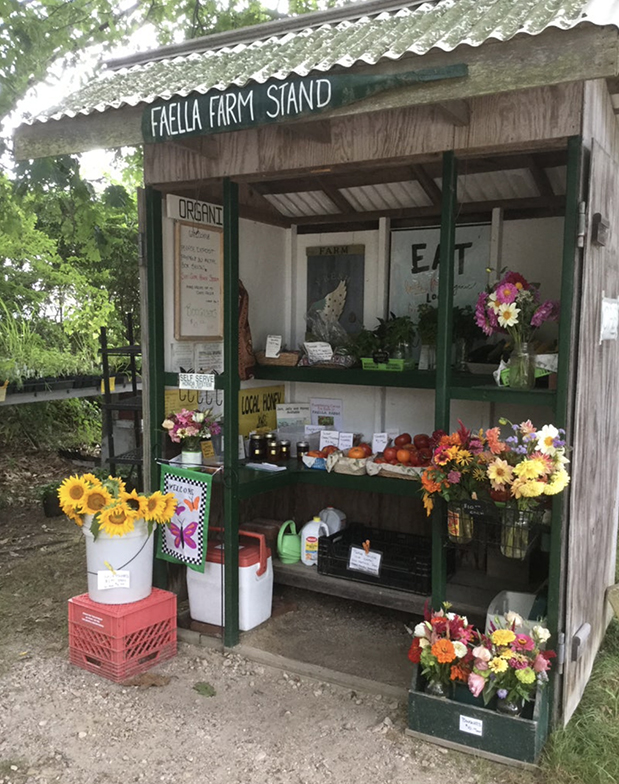A Guide to Starting R.I. Farm Stand
By Colleen Cronin / ecoRI News staff
 |
| The farm stand at Wicked Roots Micro Farm in Charlestown. |
During the height of the coronavirus pandemic, when there wasn’t much to do but twiddle our thumbs, some people decided to turn theirs green.
Whether it was starting pandemic victory gardens, learning how to can fruits and vegetables, or building chicken coops, backyard farmers sprung up everywhere and more farm stands appeared.
ecoRI
News spoke to three Rhode Island growers about the benefits and challenges of
starting a farm stand. Here is some of their advice.
When
Lou-Ann “Farmer Lou” Rippin’s father started Healey Farm on Lafayette Road in North
Kingstown more than 70 years ago, he had to drive to Providence by 3 a.m. every
day of the week to start selling his vegetables wholesale.
Today,
his daughter sells the farm’s produce through a combination of a
community-supported agriculture (CSA) program and a farm stand. The farm stand
is a much-newer endeavor than the farm itself, Rippin said, it is “only” about
40 years old.
But
it’s much easier than waking up before the rooster crows or trying to staff six
or seven farmers markets a week — something her family also did for years.
For Amanda Roberto of Wicked Roots Micro Farm, a 1-acre farm in Charlestown, staying home was also part of the appeal of the farm stand. The 32-year-old bought her South County Trail home with the thought that maybe someday she would start a farm stand, but those plans hastened recently. Roberto’s daughter was born with a rare condition that keeps Roberto working from home.
“That’s kind of why we started when we started, the drive behind it, but growing and selling and sharing my knowledge and food has always been a passion,” she said. “It’s been a plan for a long time, but I didn’t expect to do it this soon in life.”
Her
daughter, now 3 years old, is doing a lot better, and even helps at the farm
stand, mostly “dismantling and eating things,” Roberto said. “But it’s awesome
to see her be able to grow up on this little farm.”
Always do your paperwork
The first step to having a farm stand, after starting to grow your products, is
to figure out local regulations in your city or town. Farm Fresh Rhode
Island’s vendor guide suggests
reaching out to your municipality first because it may have specific vendor
license requirements.
Your
municipality could also have ordinances that restrict farm stand display or
parking. For example, in Charlestown, Roberto said the town requires that she
keep her sign under a certain size. She also must bring the sign in at night
and it can’t be lit up with Christmas lights or a spotlight. Stationed off
Route 2, Roberto said safe places for cars to park is also a huge
consideration.
Town
and city employees can also have their own good advice about how to get
started, Roberto said. “The person I spoke with was very knowledgeable,” she
said. “Really what I needed to know was spelled out pretty clearly.”
Any
new farm stand also needs to file for a Rhode Island business application and registration,
according to Farm Fresh.
Some
homeowner’s insurance policies can include coverage for a farm stand, according
to Roberto, but only for limited sales. Roberto decided to get a separate
policy, as her sales have increased during the past year and a half.
If
you are only selling fresh produce, eggs, and/or honey, you can usually stop
there. But meat producers and anyone selling canned or prepared foods needs to
take a few more steps, including reaching out to the Rhode Island Department of
Health for separate licenses. Sellers can also check with the state Division of
Taxation to see if they need to charge customers sales tax on their goods.
Farm
Fresh also has information on how to accept SNAP, WIC, and
other state food benefits at your farm stand.
When the honor system doesn’t prompt honorable actions
Often a hallmark of the farm stand, the honor system is still how many growers
operate. And although most customers follow the rules and pay for what they
take, there are some bad apples among the bunch.
Faella Farm in South Kingstown had to install a
camera to deter theft.
Chris Faella, co-owner of Faella Farm in South Kingstown and husband of its main farmer Martha, said they had to install a camera to deter theft.
When
Faella Farm started the stand in 1995, it was just a table with an umbrella,
but with the umbrella blowing over and people stealing money, they decided to
build a shed.
Still,
they had issues with theft.
“We
had people stealing our produce, usually the big-ticket items like the big jars
of jam or the honey,” Faella said. “We did have a customer stealing raspberries
for a while. But usually, people that steal aren’t very smart, and we can
slowly track them down.”
Eventually,
Faella moved the stand down the driveway and closer to the house, and during
the past few years there have been fewer problems.
Rippin
said she has also dealt with stealing at her stand.
Healey
Farm’s “stand” originally started in the back of a car 40 years ago. From
there, Rippin’s father decided to build a small building at the end of their
driveway. Like Faella, people frequently “ransacked” the building, Rippin said,
so they also decided to move it closer to their house.
Customers
came in “dribs and drabs” those first few years they were away from the road.
“Out of sight, out of mind,” Rippin said, but after a few years, sales were
back up.
Know what to grow and how to grow it
Rippin cautioned anyone starting a farm stand not to “grow stuff willy-nilly,
thinking that people will buy it because they won’t.”
Basics
such as cucumbers, sweet corn, and tomatoes do best with customers, she said.
“I
encourage people to definitely look around in their area and see what’s already
out there,” said Roberto from Wicked Roots Micro Farm, so you can try to
differentiate yourself from the nearest farms and stands. “I don’t grow
everything. I’m not great at growing everything either. Each farm is unique in
its own way.”
Roberto
also noted it’s a good idea to see how other farms are pricing their products,
so that you aren’t underselling yourself or undercutting other growers.
Farming
itself is a risky business, with plenty of obstacles in the way before any
selling can be done. Being prepared for the ups and downs and not expecting
instant success is imperative, said Rippin, who is currently battling with some
deer.
Rippin
has parked her car in front of her fence to prevent the animals, who have
destroyed her peas and are threatening her green beans, from tearing it down
over and over again.
“They
get a taste,” she said, “Then, they bring their friends with them.”
Building friendships
Despite the occasional thief, “We have some really good customers,” Faella
said.
Though
there are plenty of people who stop by while they aren’t working the stand,
they have gotten to know many of the people who come back again and again.
Roberto
agreed that one of the best parts of having the farm stand is “making people
happy with food and plants.”
In
addition to her produce, she sells starter plants, and loves showing other
people how to grow.
“Just
because I sell vegetables doesn’t mean I don’t want people growing their own,”
Roberto said. “I highly, highly encourage it. Even starting your own farm
stand.”
Colleen
Cronin is a Report for America corps member and writes about environmental
issues in rural Rhode Island and southern New England for ecoRI News.